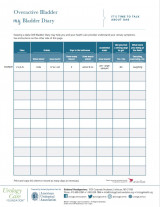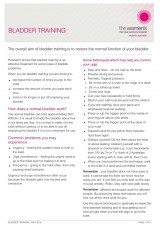Wishing everyone happy holidays and a joyful New Year from the Healthify team. Don't forget to Slip, Slop, Slap and Wrap!
Bladder training
Key points about bladder training
- The aim of bladder training is to improve bladder control and increase the amount of urine the bladder can comfortably hold, without urgency or leakage.
- A chart or diary is used to record fluid intake and urinary output.
- The aim is to gradually increase the amount of time you can wait before emptying your bladder.
- If no improvement is seen after 4–6 weeks, an individualised programme from a healthcare provider is advised.

The volume of urine (wee, mimi) passed each time by a normal adult will vary from around 250 to 400 ml. This is about 1 to 2 cups. Most people with normal bladder habits can hold on for 3 to 4 hours between visits to the toilet. Most younger adults can also go right through the night without the need to wee.
As you get older, your bladder may not be able to hold as much, so you may need to wee more often during the day and at night. Read more about overactive bladder.
There are a few reasons why you could benefit from retraining you bladder. For example if you:
- need to empty your bladder a lot – more often than normal (eg, more than every 3 to 4 hours)
- feel a real sense of urgency or need to go in a hurry
- experience leaking if you don't get to the toilet in time
- have got in the habit of going to the toilet a lot 'just in case' to avoid having an accident.
A good way to record what's happening and measure your progress is to use a bladder chart or diary. If you haven't been given a chart by your healthcare provider or continence advisor, you can draw one up yourself.
The first step
Start by filling in a bladder chart for 2 to 4 days (including overnight). Write down:
- the type of fluid you drank, the volume and the time you drank it
- the time you wee and the volume you pass
- any accidental loss of wee
- any bladder sensation you had before your episode of leaking.
The Urology Care Foundation have developed a bladder diary(external link) you might like to print off so you can record the details of what's happening for you.
Bladder training
Here are some things to do over a few weeks to help retrain your bladder.
- Start by setting some times that you want to wee, and gradually increase the time intervals between visits to the toilet.
- If you feel an urgent need to wee, try not to go straight away. Try to hold on for a minute and gradually increase the time you hold on for before going to the toilet. Over time, your bladder should learn to hold more wee.
- Try these techniques to help you hold on a bit longer:
- try to stay calm and wait until the feeling of urgency lessens (it may take a few minutes)
- distract yourself mentally by thinking about something else, talking, reading, counting backwards in your mind
- distract yourself physically by sitting straight and clenching your fists tightly, pushing the ball of your foot hard onto the floor, squeezing and holding your pelvic floor muscles, sitting down on a firm chair or the edge of a seat.
- When the feeling of urgency passes, keep going with what you were doing, or walk calmly and slowly (don't run) to the toilet.
- Practice these and see what works for you.
- Try to extend the time between trips to the toilet.
- If you need to get up at night it's fine to do that (unless you've been advised not to). As you get better at controlling your bladder during the day it may help you at night as well.
- When you have the urgent need to pass urine, you may find it helpful to sit down and try to take your mind off wanting to get to the toilet.
- When you do go to the toilet, walk, don't run.
- Avoid going to the toilet 'just in case'.
- Minimise the intake of fluids which may irritate the bladder (eg, coffee, tea, cola and alcohol) – but keep up a good fluid intake each day.
- Maintain a good bowel habit by keeping your bowel regular and avoiding constipation, as this can increase bladder sensitivity.
- Do your pelvic floor exercises – this gives you confidence to hold on. See pelvic floor training for women and pelvic floor training for men.
- Pelvic floor muscle exercises not only increase the ability to hold urine in, but also can help control an unruly, overactive bladder.
Image credit: Canva
If it doesn't work
If, after 4 to 6 weeks, the programme hasn't helped your bladder control problems, seek help. You are more likely to succeed if you work with a healthcare provider who is trained in dealing with bladder problems. They can help to design a an individual programme especially suited to you.
Support
There are health professionals qualified to help you with bladder control problems. You can seek advice and support from your healthcare provider, look for a pelvic physiotherapist(external link) who is an expert in this area, or contact Continence NZ(external link).
Apps reviewed by Healthify
You may find it useful to look at some Pelvic floor exercise apps.
Don't be concerned with small day to day variations in your bladder pattern – these are normal for everyone. However, you may find that part way through your bladder training programme you have times when the symptoms seem worse again. These may occur:
- when you're tired or run down
- during a urinary tract (bladder) infection (see your healthcare provider or pharmacist immediately if you suspect this)
- at times of anxiety or emotional stress
- when the weather is wet, windy or cold
- when you're not well, eg, when you have a cold or the flu.
If this does happen, don't be discouraged. Think positively and keep trying. It becomes easier with practice. Do keep doing the bladder training and the pelvic floor muscle exercises.
Apps
Brochures
Bladder training(external link) The Royal Women's Hospital, Australia
Overactive bladder diary(external link) Urology Care Foundation, US
References
- Bladder retraining(external link) Continence NZ
- Bladder control problems(external link) Health New Zealand | Te Whatu Ora, NZ
Brochures

Overactive bladder diary Urology Care Foundation, US

Bladder training The Royal Women's Hospital, Australia
Credits: Healthify editorial team. Healthify is brought to you by Health Navigator Charitable Trust.
Reviewed by: Dr Emma Dunning, Clinical Editor and Advisor
Last reviewed:






